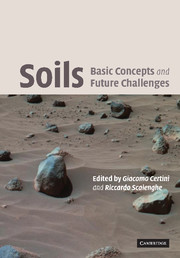Book contents
- Frontmatter
- Contents
- List of contributors
- Preface
- Acknowledgements
- 1 Concepts of soils
- 2 Pedogenic processes and pathways of horizon differentiation
- 3 Soil phases: the inorganic solid phase
- 4 Soil phases: the organic solid phase
- 5 Soil phases: the liquid phase
- 6 Soil phases: the gaseous phase
- 7 Soil phases: the living phase
- 8 The State Factor theory of soil formation
- 9 Factors of soil formation: parent material. As exemplified by a comparison of granitic and basaltic soils
- 10 Factors of soil formation: climate. As exemplified by volcanic ash soils
- 11 Factors of soil formation: topography
- 12 Factors of soil formation: biota. As exemplified by case studies on the direct imprint of trees on trace metal concentrations in soils
- 13 Factors of soil formation: time
- 14 Soil formation on Earth and beyond: the role of additional soil-forming factors
- 15 Soil functions and land use
- 16 Physical degradation of soils
- 17 Chemical degradation of soils
- 18 The future of soil research
- Appendix: Naming soils and soil horizons
- References
- Index
Appendix: Naming soils and soil horizons
Published online by Cambridge University Press: 11 November 2009
- Frontmatter
- Contents
- List of contributors
- Preface
- Acknowledgements
- 1 Concepts of soils
- 2 Pedogenic processes and pathways of horizon differentiation
- 3 Soil phases: the inorganic solid phase
- 4 Soil phases: the organic solid phase
- 5 Soil phases: the liquid phase
- 6 Soil phases: the gaseous phase
- 7 Soil phases: the living phase
- 8 The State Factor theory of soil formation
- 9 Factors of soil formation: parent material. As exemplified by a comparison of granitic and basaltic soils
- 10 Factors of soil formation: climate. As exemplified by volcanic ash soils
- 11 Factors of soil formation: topography
- 12 Factors of soil formation: biota. As exemplified by case studies on the direct imprint of trees on trace metal concentrations in soils
- 13 Factors of soil formation: time
- 14 Soil formation on Earth and beyond: the role of additional soil-forming factors
- 15 Soil functions and land use
- 16 Physical degradation of soils
- 17 Chemical degradation of soils
- 18 The future of soil research
- Appendix: Naming soils and soil horizons
- References
- Index
Summary
Naming genetic horizons
The genetic horizons are not the equivalent of the diagnostic horizons. Genetic horizons are used in profile descriptions to identify observations of soil profiles in situ. Diagnostic horizons are quantitatively defined features that are used to differentiate between taxa in soil classification systems. A diagnostic horizon may encompass several genetic horizons, and the pedogenic features implied by genetic horizon designations may not be sufficient to justify recognition of different diagnostic horizons. In genetic horizon nomenclature capital letters are used to represent the master horizons (Table I).
Where a substantial thickness is present between two master horizons a transitional or combination horizon may be described. Transitional horizons dominated by properties of one master horizon while having subordinate properties of an adjacent master horizon are designated by two master horizon capital letters. The first letter indicates the dominant master horizon characteristics and the second letter indicates the subordinate horizon characteristics. For example an AB horizon indicates a transitional horizon between the A and B horizon, but more like the A horizon than the B horizon. Also a BA horizon is a transitional horizon between the A and B master horizons but more like the B horizon than the A horizon. Other commonly designated transitional horizons include AE, EA, EB, BE, BC, CB, and AC.
Combination horizons are recognized where separate components of two master horizons are recognizable in the horizon and one of the components surrounds the other. Such combination horizons are designated as A/B, B/A, E/B, B/E or B/C. The first symbol designates the material of greatest volume in the horizon.
Information
- Type
- Chapter
- Information
- Soils: Basic Concepts and Future Challenges , pp. 265 - 276Publisher: Cambridge University PressPrint publication year: 2006
Accessibility standard: Unknown
Why this information is here
This section outlines the accessibility features of this content - including support for screen readers, full keyboard navigation and high-contrast display options. This may not be relevant for you.Accessibility Information
- 1
- Cited by
